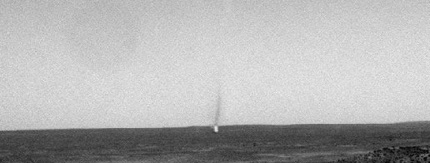Discoveries about the atmospheres of other planets have been closely linked to insights about our own. When a young Carl Sagan confirmed the effect of high CO2 concentrations—a runaway greenhouse effect—on Venus in 1960, for instance, he helped intensify interest in potential anthropogenic warming on Earth.
Conversely, climate models, and now mesoscale weather models such as the WRF, developed for Earthly forecasting, are applied to modeling conditions elsewhere. At the AMS’s first Symposium on Planetary Atmospheres in Atlanta, Scot Rafkin of the Southwest Research Institute will present, “Application of Mesoscale Atmospheric Models to Mars Missions” (Thursday, 11 a.m., B211). He’ll discuss how terrestrial weather models helped engineers anticipate landing conditions on the Red Planet as well as pick suitably interesting, but safe, landing spots.

At the same time, however, the behavior of Martian models is poorly constrained by observations. One key factor is airborne dust, which alters the way the models portray climatic processes. Mars is a complicated, prolific breeding ground for dust devils as well as massive dust storms. In the same session as Rafkin’s talk, Claire Newman of Cal Tech will explore this issue in particular in “Dust lifting on Mars: towards better representations of reality”:
To date, no numerical model of the global martian atmosphere has been able to fully capture the range and variability of martian dust storms. One major difficulty is that the largest (sometimes planet-encompassing) dust storms are global manifestations of what begin as local scale processes, and it is not feasible to run a global model at high enough resolution.
It will be interesting if this session brings up the findings on Mars reported today at the AGU fall meeting in San Francisco. A study compared the numerous small dust devils noted in video footage taken from the Mars Rover with the fewer tracks discerned from an orbiting imager. Establishing this relationship between small and more easily tracked large dust devils might lead to better parameterization of the total dust lifted off the surface by these vortices, improving the modeling of the Martian atmosphere overall.